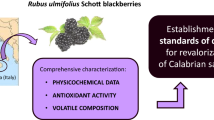Abstract
Tocochromanol composition was analysed in the seeds of nine various fruits: apple (Malus domestica Borkh.), red currant (Ribes rubrum L.), gooseberry (Ribes uva-crispa L.), grape (Vitis vinifera L.), pomegranate (Punica granatum L.), Japanese quince (Chaenomeles japonica (Thunb.) Lindl. ex Spach), sea buckthorn (Hippophae rhamnoides L.), watermelon (Citrullus lanatus (Thunb.) Matsum. & Nakai) and canary melon (Cucumis melo L.), recovered from by-products of fruit industry. The concentration range of subsequent tocopherols (Ts) and tocotrienols (T3s) was as follows: 1.29–29.30, 0.00–11.68, 0.42–95.11, 0.00–7.66, 0.03–5.03, 0.00–0.18 and 0.00–6.68 mg/100 g of seed dry weight for α-T, β-T, γ-T, δ-T, α-T3, β-T3 and γ-T3, respectively. The δ-T3 was not detected in any of the tested seeds. All tocochromanols were successfully separated by rapid RP-HPLC/FLD method and confirmed by the RP-UPLC-ESI/MS3 technique.

Similar content being viewed by others
Abbreviations
- RP-HPLC/FLD:
-
Reverse-phase high-performance liquid chromatograph/fluorescence detector
- RP-UPLC-ESI/MSn :
-
Reverse-phase ultra-performance liquid chromatography–electrospray ionisation/mass spectrometry
- T:
-
Tocopherol
- T3:
-
Tocotrienol
References
FAOSTAT (2013) FAO Statistical Database. http://www.fao.org. Accessed 12 Dec 2013
Górnaś P, Siger A, Juhņeviča K, Lācis G, Šnē E, Segliņa D (2014) Cold‐pressed Japanese quince (Chaenomeles japonica (Thunb.) Lindl. ex Spach) seed oil as a rich source of α‐tocopherol, carotenoids and phenolics: a comparison of the composition and antioxidant activity with nine other plant oils. Eur J Lipid Sci Technol 116:563–570
Górnaś P, Siger A, Pugajeva I, Segliņa D (2014) Sesamin and sesamolin as unexpected contaminants in various cold-pressed plant oils: NP-HPLC/FLD/DAD and RP-UPLC-ESI/MSn study. Food Addit Contam Part A 31:567–573
Górnaś P, Siger A, Segliņa D (2013) Physicochemical characteristics of the cold-pressed Japanese quince seed oil: new promising unconventional bio-oil from by-products for the pharmaceutical and cosmetic industry. Ind Crops Prod 48:178–182
Wie M, Sung J, Choi Y, Kim Y, Jeong HS, Lee J (2009) Tocopherols and tocotrienols in grape seeds from 14 cultivars grown in Korea. Eur J Lipid Sci Technol 111:1255–1258
Eitenmiller R, Lee J (2004) Vitamin E: food chemistry, composition, and analysis. Marcel Dekker Inc., New York
Dwiecki K, Górnaś P, Jackowiak H, Nogala-Kałucka M, Polewski K (2007) The effect of D-alpha-tocopherol on the solubilization of dipalmitoylphosphatidylcholine membrane by anionic detergent sodium dodecyl sulfate. J Food Lipids 14:50–61
Dwiecki K, Górnaś P, Wilk A, Nogala-Kałucka M, Polewski K (2007) Spectroscopic studies of D-α-tocopherol concentration-induced transformation in egg phosphatidylcholne vesicles. Cell Mol Biol Lett 12:51–69
Ruiz RP (2005) Water. In: Wrolstad RE, Decker EA, Schwartz SJ, Sporns P (eds) Handbook of food analytical chemistry, water, proteins, enzymes, lipids, and carbohydrates. Wiley, New Jersey, pp 7–8
Slavin M, Yu LL (2012) A single extraction and HPLC procedure for simultaneous analysis of phytosterols, tocopherols and lutein in soybeans. Food Chem 135:2789–2795
Górnaś P, Siger A, Czubinski J, Dwiecki K, Segliņa D, Nogala-Kalucka M (2014) An alternative RP‐HPLC method for the separation and determination of tocopherol and tocotrienol homologues as butter authenticity markers: a comparative study between two European countries. Eur J Lipid Sci Technol. doi:10.1002/ejlt.201300319
Górnaś P, Siger A, Polewski K, Pugajeva I, Waśkiewicz A (2014) Factors affecting tocopherol contents in coffee brews: NP-HPLC/FLD, RP-UPLC-ESI/MSn and spectroscopic study. Eur Food Res Technol 238:259–264
Cenkowski S, Yakimishen R, Przybylski R, Muir W (2006) Quality of extracted sea buckthorn seed and pulp oil. Can Agric Eng 48:3.9–3.16
Fromm M, Bayha S, Kammerer DR, Carle R (2012) Identification and quantitation of carotenoids and tocopherols in seed oils recovered from different Rosaceae species. J Agric Food Chem 60:10733–10742
Habibnia M, Ghavami M, Ansaripourc M, Vosough S (2012) Chemical evaluation of oils extracted from five different varieties of Iranian pomegranate seeds. JFBT 2:35–40
Raziq S, Anwar F, Mahmood Z, Shahid S, Nadeem R (2012) Characterization of seed oils from different varieties of watermelon [Citrullus lanatus (Thunb.)] from Pakistan. Grasas Aceites 63:365–372
Nyam KL, Tan CP, Lai OM, Long K, Che Man Y (2009) Physicochemical properties and bioactive compounds of selected seed oils. LWT Food Sci Technol 42:1396–1403
Mariod A, Matthäus B (2008) Fatty acids, tocopherols, sterols, phenolic profiles and oxidative stability of Cucumis melo Var. agrestis oil. J Food Lipids 15:56–67
Goffman FD, Galletti S (2001) Gamma-linolenic acid and tocopherol contents in the seed oil of 47 accessions from several Ribes species. J Agric Food Chem 49:349–354
Shintani D, DellaPenna D (1998) Elevating the vitamin E content of plants through metabolic engineering. Science 282:2098–2100
Fromm M, Bayha S, Carle R, Kammerer DR (2012) Comparison of fatty acid profiles and contents of seed oils recovered from dessert and cider apples and further Rosaceous plants. Eur Food Res Technol 234:1033–1041
Aggarwal BB, Sundaram C, Prasad S, Kannappan R (2010) Tocotrienols, the vitamin E of the 21st century: its potential against cancer and other chronic diseases. Biochem Pharmacol 80:1613–1631
Rimm EB, Stampfer MJ, Ascherio A, Giovannucci E, Colditz GA, Willett WC (1993) Vitamin E consumption and the risk of coronary heart disease in men. N Engl J Med 328:1450–1456
Stampfer MJ, Hennekens CH, Manson JE, Colditz GA, Rosner B, Willett WC (1993) Vitamin E consumption and the risk of coronary disease in women. N Engl J Med 328:1444–1449
Acknowledgments
This research was supported by the National Research Programme “Sustainable Use of Local Resources (Entrails of the Earth, Forest, Food and Transport)—New Products and Technologies” project “Improvement and maintenance of apple quality, and new processing possibilities” (2010–2013).
Conflict of interest
None.
Compliance with Ethics Requirements
This article does not contain any studies with human or animal subjects.
Author information
Authors and Affiliations
Corresponding author
Rights and permissions
About this article
Cite this article
Górnaś, P., Pugajeva, I. & Segliņa, D. Seeds recovered from by-products of selected fruit processing as a rich source of tocochromanols: RP-HPLC/FLD and RP-UPLC-ESI/MSn study. Eur Food Res Technol 239, 519–524 (2014). https://doi.org/10.1007/s00217-014-2247-3
Received:
Revised:
Accepted:
Published:
Issue Date:
DOI: https://doi.org/10.1007/s00217-014-2247-3




